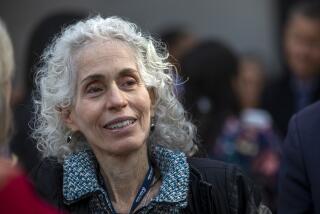Cancer’s price tag
“So how much for that surgery to remove my breast and possibly save my life?” Cancer patients seldom ask that or other cost-related treatment questions in an oncologist’s office. And, even if they did, many oncologists wouldn’t know the answer or would want to separate treatment from expenses.
But a study released earlier this month found that even cancer patients who have health insurance are seeing their expenses mount as deductibles and cost-sharing continue to rise each year. And an earlier study found that about half of all personal bankruptcies are the result of heavy medical debt -- most declared by people with insurance. For those with no insurance, the situation is much more dire.
Such trends are pushing patients, doctors and oncology support staff to talk frankly about costs, make some treatment decisions with expenses in mind and look for government, national and community organizations that may be able to help with some expenses. A Harvard School of Public Health survey two years ago found that 22% of cancer patients with health insurance used up most or all of their savings on cancer-related costs; 5% decided to forgo some care because of costs.
“Recent research shows that the cost of cancer care is increasing at a rate of 15% per year -- nearly three times the rate of increase of overall healthcare costs in the country,” says Dr. Richard Schilsky, president of the American Society of Clinical Oncology. “In addition,” he says, “the newest cancer drugs can cost thousands of dollars per month of treatment, and many families report problems paying their cancer care bills.”
The organization even recently released an online guide to managing cancer expenses. (Go to www.cancer.net and look under “New.”) The guide includes a glossary of cost terminology (such as “co-pay” and “out of network care”), recommended cost-related questions (such as “If I cannot afford this treatment plan, can we consider other treatment options that don’t cost as much?” and “Are there ways to change my treatment schedule, if necessary, to work around my job or child care?”) and links to organizations that may be able to help with expenses. (See resource box for additional links.)
--
Doctors shy from topic
Neal Meropol, an oncologist at the Fox Chase Cancer Center in Philadelphia who helped produce the online guide, says he’d like to see physicians begin to weave cost into their knowledge of cancer care while in medical school. If that happens, it could be a boon to patients. A survey of just over 160 oncologists, published two years ago in the Journal of Clinical Oncology, found that 31% felt uncomfortable discussing costs with patients. Also, 42% said they always discuss treatment cost, 32% sometimes did and 26% said they rarely or never did.
The growing need for frank conversations about the high cost of cancer care was underscored by the report published in early February by the Kaiser Family Foundation, a nonprofit health research group based in Menlo Park, Calif., and the American Cancer Society. The report found that even cancer patients who have insurance can find themselves bearing costs that are difficult to pay off.
Thomas Olszewski, 62, of Graham, Texas, was treated for prostate cancer in 1999 and needs yearly tests so that any recurrence can be detected early. But his insurance comes with an annual $3,750 deductible, and he still owes $500 from his last checkup. He now has his cancer checkups every other year, instead of annually. “I am afraid to go to the doctor,” Olszewski says, “because I never know how much it will cost me.”
Schilsky, also an oncologist at the University of Chicago Medical Center, says that, difficult as it is, some patient-doctor conversations should include whether the patient wants to continue care that could be a long shot and leave patients or their families saddled with debt -- particularly when the prognosis is poor and many treatment options have already been exhausted.
“The decision is up to the patient, but the doctor should facilitate that conversation. We treat whole patients, not just an isolated cancer,” Schilsky says.
Along those lines, Meropol says a chemotherapy patient recently told him that a prescribed anti-nausea drug was just too expensive. The doctor then prescribed a less expensive but also somewhat less effective drug.
--
Resources are available
Arash Naeim, head of the geriatric oncology program at UCLA Medical Center, says he hopes that by having the physician bring up cost, patients will feel more comfortable discussing their needs and concerns, and doctors can then refer patients to financial and social work staff to see if resources might be available or if a payment plan can be worked out. Paying at least something regularly shows good faith that could garner added assistance from the billing office.
Jamie Drzewicki, 58, of Pembroke Pines, Fla., who was diagnosed with breast cancer more than two years ago, reached her annual health insurance limit of $100,000 a few months after her diagnosis and ended up owing about $75,000 for her treatment. She paid at least something regularly and, though she still owes $30,000, the hospital recently forgave $40,000 of the debt
Diane Blum, head of CancerCare, a national social service agency that offers counseling and financial assistance for cancer patients, says financial assistance from CancerCare and other agencies can be based on a patient’s income as well as availability of funds. Some agencies have funds that cover a particular cancer, but stop giving out money once that allotment is used up. If that’s the case, patients can apply to other agencies, and reapply to the closed fund the following year, if necessary, when coffers may have been refilled.
Blum and others also suggest that cancer patients cede the financial quests, at least at first, to a trusted friend or family member as they take in the news about the cancer and begin treatment.
There is no guarantee of assistance, especially now, when so many people are losing their jobs and their insurance and many will likely need help with costs, Blum says. But it can’t hurt to try.
Just ask Maria D’Acosta, 59, of Carlsbad and her daughter, Paola Campos-D’Acosta, 30. Campos-D’Acosta left her job with a temporary employment agency in New York City after being diagnosed with breast cancer last summer. She had no insurance when doctors told her she’d need a mastectomy and chemotherapy to treat the Stage 3B cancer, and is now $100,000 in debt.
--
Help for mom, daughter
Social workers at Harlem Hospital, the city hospital where she had a mastectomy, recommended applying to Medicaid in New York state to cover her bills retroactively, and a friend referred her to the Ralph Lauren Center for Cancer Treatment and Prevention, affiliated with Memorial-Sloan Kettering Medical Center in New York City.
Just before coming to New York to look after her daughter, D’Acosta felt a lump in her own breast and mentioned it to her daughter’s doctors. They insisted she have a biopsy, which showed the lump to be malignant. D’Acosta, who closed her interior design business last year, had dropped her insurance some months before, as business dwindled.
Now she too is getting her care at the Ralph Lauren Center for low-income women, where both women pay a $50 co-pay for doctor visits, with costs mounting. Family and friends are helping out.
But one concern they don’t have, in a city filled with studios renting at $2,000 or more per month, is how to pay for their living space.
The women have been living in two cozy rooms near New York’s famed Penn Station, free of charge, since November. They’re at the American Cancer Society’s Hope Lodge, where cancer patients referred by their medical team can stay, first come, first served, for as long as treatment is ongoing. In addition to private rooms, the lodge offers communal kitchens, computer rooms, open areas, meditation rooms and even cooked dinners a few times a week.
“The cancer, that’s a shock,” D’Acosta says, “but we’re blessed to be living in this place while we get our care.”
Don’t assume your income is too high to ask for help, says David Knowlton, a board member of the Healthwell Foundation, based in Gaithersburg, Md., which provides financial assistance for insurance premiums and co-pays for patients with many different conditions. Knowlton says grants might even be made to families with a yearly income of $80,000 or higher, depending on family size and other circumstances.
“This is a tough time for too many people,” Knowlton says, “and funds are trying to help as much as they can.”
--
--
(BEGIN TEXT OF INFOBOX)
Where to get help
Assistance to cancer patients can come in many forms -- funds for care, free stays, transportation and even personal grooming items such as wigs and makeup. Here are some good places to start your search.
NATIONAL CANCER INSTITUTE
www.cancer.gov or (800) 422-6237
Besides offering information on cancers and clinical trials, this federal institute offers support information. From the home page, click on “Cancer Topics,” then look for “Support and Resources.”
CANCERCARE
www.cancercare.org or (800) 813-4673
This nonprofit agency has social workers who can refer you to sources of financial aid and other assistance.
CANCER.NET
www.cancer.net/managingcostofcare
This patient-focused site, sponsored by the American Society of Clinical Oncology, offers a guide on managing costs of care. For organizations that help with such costs, click on “Financial Resources” from the guide’s home page.
AMERICAN CANCER SOCIETY
www.cancer.org or (800) 227-2345
Operators can provide information on assistance, or you can key in “financial assistance for the cancer patient” in the search engine.
-- F.L.K.


